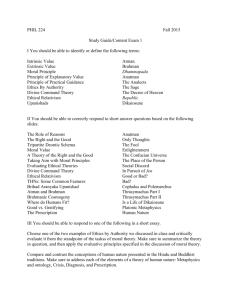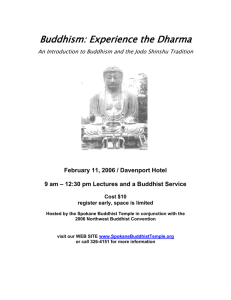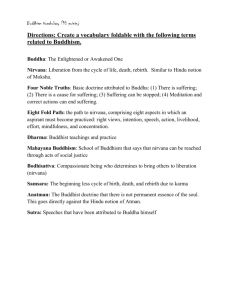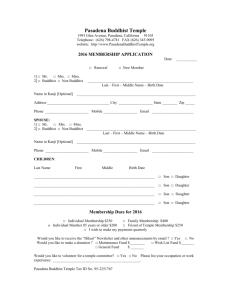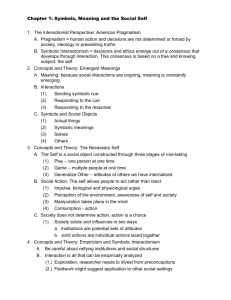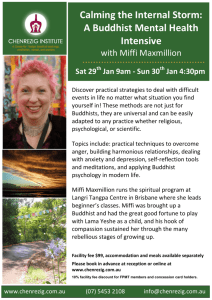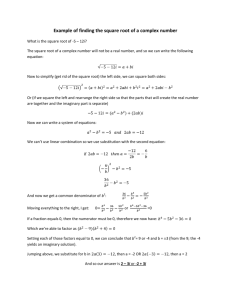Taking Anatman Full Strength and Śāntideva's Ethics of Truth
advertisement
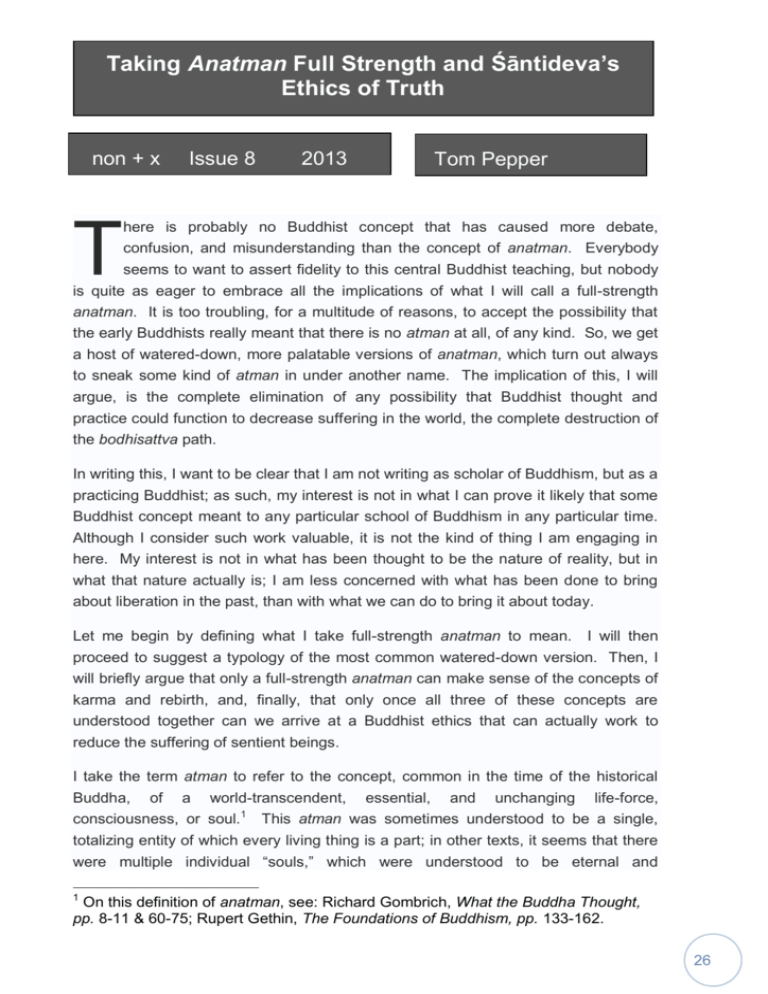
www.nonplusx.com Taking Anatman Full Strength Taking Anatman Full Strength and Śāntideva’s Ethics of Truth non + x T Issue 8 2013 Tom Pepper here is probably no Buddhist concept that has caused more debate, confusion, and misunderstanding than the concept of anatman. Everybody seems to want to assert fidelity to this central Buddhist teaching, but nobody is quite as eager to embrace all the implications of what I will call a full-strength anatman. It is too troubling, for a multitude of reasons, to accept the possibility that the early Buddhists really meant that there is no atman at all, of any kind. So, we get a host of watered-down, more palatable versions of anatman, which turn out always to sneak some kind of atman in under another name. The implication of this, I will argue, is the complete elimination of any possibility that Buddhist thought and practice could function to decrease suffering in the world, the complete destruction of the bodhisattva path. In writing this, I want to be clear that I am not writing as scholar of Buddhism, but as a practicing Buddhist; as such, my interest is not in what I can prove it likely that some Buddhist concept meant to any particular school of Buddhism in any particular time. Although I consider such work valuable, it is not the kind of thing I am engaging in here. My interest is not in what has been thought to be the nature of reality, but in what that nature actually is; I am less concerned with what has been done to bring about liberation in the past, than with what we can do to bring it about today. Let me begin by defining what I take full-strength anatman to mean. I will then proceed to suggest a typology of the most common watered-down version. Then, I will briefly argue that only a full-strength anatman can make sense of the concepts of karma and rebirth, and, finally, that only once all three of these concepts are understood together can we arrive at a Buddhist ethics that can actually work to reduce the suffering of sentient beings. I take the term atman to refer to the concept, common in the time of the historical Buddha, of a world-transcendent, essential, and unchanging life-force, consciousness, or soul.1 This atman was sometimes understood to be a single, totalizing entity of which every living thing is a part; in other texts, it seems that there were multiple individual “souls,” which were understood to be eternal and 1 On this definition of anatman, see: Richard Gombrich, What the Buddha Thought, pp. 8-11 & 60-75; Rupert Gethin, The Foundations of Buddhism, pp. 133-162. 26 www.nonplusx.com Taking Anatman Full Strength unchanging. The teaching of anatman, then, can be understood as an assertion that there is no eternal and unchanging consciousness, life force, or soul, singular or plural, nothing which can escape this dependently arisen world and continue on in eternal bliss. Rather, the only kind of self we have is a dependently arisen self, completely caused by the conditions of its existence. Full-strength anatman, then, does not say that we do not have a “self,” that the self is mere illusion, or that it is non-existent. Rather, we do have a self, it is real, and has real causal powers, but it is impermanent, constructed by the conditions of its existence, can be changed, will come to an end, and is completely non-dualistic, radically immanent to the material world. Translating anatman as non-self, then, is likely to lead to confusion. We certainly do have a self, and it is unique, real, and can act in the world. It is just as real, and in the same way, as a chair or the legal system of the United States. All such things exist, and can serve purposes, either useful or obstructive. They can all be changed, or eliminated, and, importantly, they have no “essential nature,” no “ideal form” which they manifest. They simply arise out of causes and conditions, and will no longer exist once those causes and conditions cease to exist. The difficult thing for most Buddhists to accept, it seems, is that consciousness is arisen from causes and conditions, and is impermanent, in exactly the same way that our physical bodies are, in exactly the same way that toadstools or doorstops are. The entire, collective existence of human consciousness occurred only because the causes for it happened to occur, and once we finish making the planet uninhabitable for human life, it will cease to exist completely. It is, it seems to me, the reluctance to accept this fundamental teaching of early Buddhism, the radical contingency and impermanence of consciousness, that has led to a host of watered-down versions of anatman which are much easier to swallow. Most people don’t seem to have trouble accepting that the Buddhist teaching of impermanence applies to their body, their loved ones, their house, the earth—but they draw the line at the impermanence of their consciousness. I plan to argue that it is only by accepting this reality that we can stop suffering. Further, I will argue something that might initially seem paradoxical (but, ultimately, is not): only by accepting a full-strength anatman can we make sense of the concepts of rebirth and karma, and see our obligation to devote our lives to making the world better for others. First, I want to outline what I take to be the four most common versions of watereddown anatman, in order to clarify what my understanding of anatman entails, and to begin to demonstrate why it is that anything short of a full-strength anatman fails to 27 www.nonplusx.com Taking Anatman Full Strength show us the way to end suffering. I will not quote, or name, the proponents of these various versions of diluted anatman, to avoid needless defensiveness and quibbling. Many Western Buddhists alternate between them, or produce various combinations of them. My goal in this essay is not scholarly critique, but the proposal of a particular understanding of important concepts. For this reason, I have not offered any textual warrant for my understanding of anatman: while it would be easy enough to present such warrant, my point is that it is just as easy to find passages in Buddhist texts which present what I am calling incomplete, or watered-down, anatman. The point is not to determine which position has the greatest number of adherents, but which position is true to the way the world actually is. It is my argument that any position which requires us to deny or ignore the way the world actually is will always lead to suffering. Four Kinds of Incomplete Anatman One of the most common translations of anatman in popular Buddhism is egolessness. The translation itself indicates how this version of atman is made more acceptable to a popular audience. Drawing on the common-language meaning of the word ego, anatman is understood to mean that we should not think too highly of our selves, should not be proud, vain, or narcissistic. “Ego” is used as a convenient way to conflate two different concepts, and to transform a philosophical into an ideological concept. On the one hand, “ego” is a socially constructed sense of self that serves a function. The ego, in the psychoanalytic sense of the term, is a construct that enables us to operate in the world more easily (most of the time), but, for Lacan particularly, is an error or “misrecognition” when we mistakenly believe that it is the real core of our subjectivity. That is, when we make the mistake of believing that our ego has agency, is the locus of our subjectivity, we can run into trouble. We won’t always run into trouble, and for many people this misrecognition will work just fine, and they will go about their lives of quiet desperation stuck in a common delusion. In this sense, there is a connection between anatman and ego, because the goal of understanding anatman would include understanding that the ego is a construct, that it is not permanent, and is not the true locus of our agency. This does not mean that we should be “without” an ego, or that the ego does not really exist. It exists, is useful to us in the world, and we cannot function without it and should not try to. We do not want to be “egoless,” but simply to recognize the true nature of the ego. One can, however, believe oneself to be “egoless” in this sense, and still be thoroughly attached to the idea that one has a deeper “true self” or essential nature that is other than, or deeper than, the socially constructed “ego.” 28 www.nonplusx.com Taking Anatman Full Strength The term egotistical, of course, commonly means thinking too highly of oneself, exaggerating one’s own good qualities, or even arrogance in the true sense of term (assuming one is right and so refusing to consider evidence to the contrary). Eliminating these things may be valuable, but this is not what is meant by the term anatman. It is perfectly possible to be humble, think poorly of oneself, and always consider all possible evidence, and still believe in the existence of an eternal and unchanging core “self.” This translation of anatman has been highly useful for Western Buddhism ideologically. It allows Buddhism to become thoroughly quietist politically, since anyone attempting to change anything in the world can be said to be asserting her ego and so to be a bad Buddhist. It also fits well with Christian ideas of humility and meekness. Probably most importantly, it protects postmodern relativism, because anyone attempting to argue for any truth can be accused of being egotistical and so of not understanding the core Buddhist truth. Finally, of course, it protects the attachment to the belief in an atman, because the only thing we must believe does not exist is exactly the only thing that does exist: we can be convinced that the socially-constructed self is a “mere illusion,” and that we have a world-transcendent self that remains untouched by anything the illusory “ego” does in the world. In this way, anatman serves to give us permission to participate in oppressive and destructive social systems, with confidence that these immoral actions cannot touch our “true selves.” This leads to the second watered-down version of anatman. It is common to hear, often supported by carefully edited citations from the Pali canon, the idea that anatman means that my body, my thoughts, my habits, my job, my emotions, etc, are “not my self.” This, unfortunately, gets it exactly backwards. The point of the concept of anatman is that those things are exactly the only kind of self we have! The typical meditation technique of “noticing” our thoughts and then “letting them go,” then, serves only to create the illusion that we have some kind of deeper “true self” which can passively observe these thoughts as they come and go, detached and indifferent because completely unaffected by such trivialities. Instead, we should be working to recognize that our thoughts, our actions, our social roles, are exactly what the self is, and the only way to change the self for the better is to think, take action, and change the roles we take on in the world. Understanding anatman should lead us to an acceptance that the self is impermanent, constructed in social structures, and changeable. The conventional self is the only kind of self we have at all. This does not make it any less real, does not make it a “mere illusion,” as we so often hear Buddhist teachers tell us. A wall is impermanent, changeable, and constructed within a human social system, but it is certainly not a mere illusion. 29 www.nonplusx.com Taking Anatman Full Strength This is not to say that there are no illusions or errors. The mistaken belief that we can “witness” our thoughts from some unconstructed “true self,” for instance, is one such error. There is a real social practice which is at work here, of course; it is the social practice of the mediation retreat or workshop in which we do this. That is, the “true self” we think is observing this constructed self is just a different constructed self, one which we are now mistaking for an unconstructed and permanent entity, but which is constructed by our Buddhist practice. This “true self,” then, is an error, and illusion, because it is a constructed entity that we are mistakenly convinced is unconstructed. The practice of constructing this illusion, of course, serves the ideological function of helping us to avoid the unpleasant work of actually thinking, acting, and changing our social roles, work that we would have to do to reduce suffering for ourselves and others. (My argument will ultimately be that once we understand anatman completely, this work will no longer be so unpleasant.) The third and fourth partial understandings of anatman take a slightly different approach. The first two versions want to accept that there is no self, but think that accepting this means we should get rid of the conventional self, and so end up assuming the existence of some kind of atman without acknowledging it. The second two simply assert the existence of an atman, defining it in exactly the same way as the atman that is rejected in early Buddhist texts, but insist that if they simply refuse to call it an atman, then it is not one. This is the approach that says there is a “true self” or “big mind” or “substrate consciousness,” some kind of consciousness without an object, which can perceive the world “purely” without any cognition. In the instant of this “pure” and thought-free perception of the world, one achieves recognition of the eternal consciousness that will survive this world. This, of course, is exactly the Vedantic concept of atman, and is exactly what the Buddha was arguing does not exist, and what we must recognize does not exist in order to end our suffering. Small wonder, then, that so many of the Western Buddhists seeking this (non-existent and so impossible) “pure perception” and trying to experience the “substrate consciousness” remain so dissatisfied, unhappy, and ultimately give up; small wonder, also, that so many Buddhist teachers who are deluded enough to believe they have experienced this and can teach it to others are mired in scandal. What distinguishes these two (mis)understanding of anatman is simply whether the atman which they do not call an atman is multiple or single. For the majority, the pure consciousness that is trapped in the phenomenal body by the tangle of conceptual thought is multiple, each individual having her or his own substrate consciousness and individual karma. One can, then, achieve liberation in solitary retreat from the world. There is, however, a position that would hold that what anatman really means is that we do not have these individual atmans, that we don’t 30 www.nonplusx.com Taking Anatman Full Strength have single and separate souls, but are all part of one collective world-transcendent soul. On this version, once we recognize that we are all part of one big soul, we can become awakened as a group—but still, only so long as we recognize that our thoughts, emotions, actions, etc. are not part of this eternal non-atman. Anatman then is a name for this thing that is the very definition of the atman for Vedanta, but which, by refusing to call it that, by calling it the opposite of what it is, we are supposed to believe becomes something different—that it becomes somehow “secularized,” modern, or non-superstitious simply by negating its name. Of course, the acceptance of our own mortality, our impermanence and relative insignificance in the universe, is doubtless the major reason that the Buddhist path has always been declared to be so difficult. The reactionary cooptation of Buddhism, of course, would always seek to displace this difficulty onto demanding and lengthy training periods and mystical states of consciousness nobody alive can claim to have attained. In seeking to prevent, rather than enable, the transformation of social structures in ways that might prevent suffering, institutional Buddhism has often constructed elaborate practices which exactly serve to reinforce this illusion of an eternal and abiding self. Conservatism generally depends heavily on essentialism of one kind or another. Still, one might think that in our thoroughly secular age, when nobody is any longer so naïve as to believe in God or a soul, it would become easier, not more difficult, to become enlightened that it seems to have been in the time of the Buddha. In ancient texts it seems that many people became enlightened, even without attaining any supernatural powers or achieving some perfection of their character which transformed them into charismatic avuncular sages. Today, when this acceptance of our impermanence and relative insignificance is a regular part of the secular worldview, why is the core Buddhist insight still so difficult to achieve? The reason, I would argue, lies partly in this secular and scientific world-view, and its assumptions about the particular kinds of causes and conditions which give rise to the existence of the mind. To realize full-strength anatman, then, I will suggest that we need to consider what kind of thing the mind is, and what it arises dependent upon. Naturalism Without Atomism My suggestion in this section is that we cannot begin to understand Buddhist thought, to really grasp the insight necessary to liberation, until we understand that the mind is 31 www.nonplusx.com Taking Anatman Full Strength not in the brain. Thought, and therefore the mind, is not correspondent to, an epiphenomenon of, or in any way limited to the anatomy, activity, or capacity of the brain. Further, I want to assert that this can be understood in a completely naturalist manner, with no recourse whatsoever to any kind of dualism, or any idea of a spirit or soul. I use the term “atomism” metaphorically here. Most people have absorbed enough of the popular representations of quantum theory to no longer think of the universe as being made up of elementary particles interacting in a void. However, we still think of the mind in this way. Each individual is understood to have a discrete mind, contained in her brain, and interacting with the world in sensory experience. We may accept that there are some dispositions that are innate, but the mind is a result of unique memories and experiences. This model of the mind is a nearly universal assumption in Western thought since Locke’s Essay Concerning Human Understanding. Of course, it has led to endless difficulties, to the perennial “mind/body problem” which can never, it is commonly asserted, be solved. It has also led to a pointless fascination with brain imaging and the idea that enlightenment can be detected in the relative density of certain neural pathways, not to mention the constant claims that meditation must really work because it changes the shape of the brain. Changing the shape of the brain, of course, is not always a good thing. But more importantly, it has nothing whatsoever to do with insight into the true nature of things. If you should find out tomorrow that your spouse has been cheating on you for years, surely that would change your understanding of the true nature of your reality and have a profound impact on your actions in the world, but there would be no correspondent change in the morphology of your neural pathways. Thought does not map onto the brain in any such way, although it is, of course, dependent on the brain. To assume that our thoughts arise from neurons is analogous to the assumption that a radio broadcast arises from the wires and circuits in a radio. The brain and the radio are necessary, but not sufficient, causes of thought and the broadcast. Where, then, is the mind? In order to answer this question clearly and concisely, I will offer a sort of “introductory” account of a theoretical position that, while fairly well established, has not quite achieved popular status. I will set aside, for now, scholarly reference and debate, and simply offer my understanding of this position in what I hope will be an accessible manner. The mind, while dependent on the brain, is not in any way reducible to the brain. This is true because the mind, and so thought, does not completely (and possibly not mostly) take place within single brains, but takes place in a symbolic/imaginary 32 www.nonplusx.com Taking Anatman Full Strength structure which incorporates or makes use of multiple brains for its existence. The concepts of symbolic and imaginary to which I am referring are part of the Lacanian discourse of psychoanalysis, and I will give a brief and simplified account of them here.2 The symbolic is the “order,” in Lacan’s terms, of language and other systems of meaningful communication. Language always occurs between multiple individuals, and to become fully human is to enter into an already existing symbolic system and so become part of a collective mind. Or brain must, in a sense, “tune in” to the mind that already exists in order to become part of human consciousness. Language, obviously, does not seek to label the world—as if we were trying to paste labels onto every individual thing so that we could use the label to refer to the concrete particular in its absence. Instead, we must understand language as functioning to create categories, abstractions, and to produce a construal of the world which enables us to conceive of how things work and what we can do—both mind-independent things and social structures are categorized and construed in language. Unlike Humpty Dumpty in Through the Looking Glass, of course, we cannot make words mean whatever we want them to mean. The meaning of a word is always, must always be, socially negotiated. So the symbolic order is always the site of an ongoing negotiation for the best construal of the world, the one that suits the needs of the most bodily individuals. There is, then, no thought at all, for a human subject, outside of language. We do not “think” and then try to “find the words to say” what we have in mind; instead, we can only think in language, and when we are “speechless” it is not because of a thought we cannot express, but because of some experience we cannot think symbolically. The imaginary order, then, is the realm of perceptual and bodily experience, of our non-verbal sense of the world, our attachments to particular structures of experiencing. This is also something that is socially constructed, that we acquire from our culture and experiences. Our enjoyment of certain types of music, certain foods, palettes of color, ways of sitting, types of clothing, sense of personal space, perceptions of attractiveness, all of these are in the order of the imaginary. The symbolic and the imaginary interact, and shape one another. A repeated perceptual experience may cause us, collectively, to produce a new symbolic concept, but discovering a new symbol, a new word or term already in use, can also alter the way we perceive something—as when we suddenly begin to “notice” something more 2 For a fairly clear introductory account of what I am discussing here, see Malcolm Bowie, Lacan. For more sophisticated discussions of what I am oversimplifying dramatically, see Bruce Fink, The Lacanian Subject, and Joël Dor, Introduction to the Reading of Lacan. 33 www.nonplusx.com Taking Anatman Full Strength acutely once we know the term for it. It is important here to keep in mind that our non-verbal sensations and perceptions are always just as thoroughly socially constructed as our language and concepts. There is never any such thing as a “pure perception of reality as it is,” because all perceptions are in the imaginary order, and are thoroughly socially constructed. To attempt to escape thought and access the purely perceptual then, as many Buddhist teachers suggest, is not to escape our cultural construction and to see the ultimate, but is to drop the one chance we do have of seeing how culturally constructed our perceptions are. It is only because there are two orders, which will sometimes not perfectly align, that we can use language to understand how our very sensations are dependently arisen. To try to get “beyond thought,” then, is the very opposite of awakening: it is the absolute reification of our dependently arisen construal of the world, the delusory mistaking of our imaginary structure for mind-independent reality. It is crucially important that we avoid this reification, because it is only the ability to recognize the symbolic/imaginary structure as socially created and changeable that can allow us to reduce human suffering. Once we understand mind in this way, as a socially produced symbolic/imaginary system which makes use of multiple individuals (including their brains), the perpetual mind/body problem of philosophy simply dissolves. There is no need to account for how an individual mind arises out of an individual brain, because no such thing occurs. A human being who has never had any contact with other humans (Kipling’s Mowgli for instance) would never have a mind in this sense, and would not have the capacity for awakening which makes birth as a human being so important in Buddhist thought. We are unique (at least on this planet) in the ability to use symbolic systems of communication, and so are the only species capable of escaping the determinism of our natural history. Language is what allows us to become enlightened. I won’t debate, here, the ubiquitous assertion that true enlightenment requires that we get outside of language, other than to point our that if this was the Buddha’s point, he was awfully long-winded in making it. This understanding of the causes and conditions of the mind is crucial to really grasping the meaning of full-strength anatman. Because if anatman means that we do have very real “selves,” but that these selves are dependently arisen, impermanent, and corrigible, then the benefit of grasping the meaning of anatman is that we can see exactly how these selves are constructed, how the social structures which construct them contribute to suffering, and how we can work to change those structures and reduce suffering. If anatman meant only that this socially-constructed self was an illusion, and that any socially-constructed self inherently suffers, then the most logical next step would be to kill ourselves immediately. However, since 34 www.nonplusx.com Taking Anatman Full Strength anatman means that there is no transcendent soul, self, or consciousness of any kind, but only this socially-constructed self exists, the obvious response, the only response that makes sense, is social action. We cannot improve the self without improving the collective symbolic/imaginary system of which it is a part. To attempt this is as futile as expecting a particular radio station to play a different song on my radio than it plays on everyone else’s. There are, of course, different stations broadcasting on the airways (to perhaps push the metaphor a bit too far), and there are multiple collective minds, multiple symbolic/imaginary systems, on earth—and even in any individual city or town. We can, to a degree, choose which collective mind to belong to, but we cannot simply refuse to belong to one at all (not even a hermit is completely outside of some collective subjectivity). The terror of absolute loss of individualism that so often keeps people from considering this understanding of the mind is unfounded. Not only will there always be multiple collective minds, but since a mind is a collective, it requires multiple individuals participating in its reproduction, and each individual must necessarily inhabit a unique place in the system, having unique perspective and bodily experiences, or the system would fail to adapt and grow, would fail to exist. This particular mechanism for the dependent arising of the mind may not be one that can be found in early Buddhist texts, but I believe it in no way contradicts them. It is simply our modern explanation, a more familiar discourse, in which to explain how the mind occurs completely within the laws of nature, how it arises and thinks and changes and grows, with no need for recourse to any kind of eternal or dualistic entity. Concepts like karma and rebirth, then, can be understood as completely naturalistic. What is rebirth but the continuation of the symbolic system beyond the life of an individual body which is one of its parts? If my mind just is a part of this symbolic system, then wouldn’t it be obvious that I must be concerned with the welfare of all the other individuals in this system, and also concerned with how the symbolic system operates as a whole? What I do in this life can perpetuate, as well as reshape, the symbolic system which will continue after this individual body is gone; my mind, or the collective mind in which I participate, will bear the consequences of what I do with this individual body. Karma and rebirth aren’t mystical or primitive beliefs, but perfectly logical consequences of the dependent arising of the collective mind. Taking anatman full-strength, far from eliminating motivation for moral action, should be the greatest motivator of all. Finally, then, I want to turn to the thought of the Madhyamaka Buddhist Śāntideva, as an example of a Buddhist thinker who took his anatman full-strength, and drew from it the conclusion that we are all obliged to follow the bodhisattva path. 35 www.nonplusx.com Taking Anatman Full Strength Śāntideva’s Ethics of Truth The common reading, the “obvious” reading, of Śāntideva’s Bodhicaryavatara is that it proposes a virtue ethics: we should perfect our capacities for generosity, forbearance, etc., in order to be better bodhisattvas, to improve our ability to produce the conditions for liberation for all sentient beings. 3 This reading raises some difficulties, though, not least of which is that the entire treatment of the paramitas of dana and sila consists of two verses (5. 10-11).4 Moreover, Śāntideva’s suggestion for perfecting these paramitas is far from the cultivation of habits or dispositions that would be expected in a virtue ethics. In both cases, he suggests that the virtue is perfected once the “mental attitude” is achieved. There is no need to develop the habit or character trait of generosity through practice; we need only achieve the correct understanding to be true bodhisattvas. It is not surprising, then, that much more attention is given to the perfections of dhyana and prajna, meditation and wisdom. For Śāntideva, awakening is something done with the mind, with mental effort, not by developing virtuous habits. As Paul Williams has put it, for Śāntideva “the spiritual path is not one of comfortable feelings and acceptance. It is deeply uncomfortable, and one cause of that necessary uncomfortableness is the persistent search for truth through employing rather than denying our critical faculties” (“General Introduction,” xxv). The goal, for Śāntideva, is never to escape “discursive thought,” in meditative states; rather, as Crosby and Skilton explain, Śāntideva encourages the cultivation of the “first meditative absorption, where discursive thought is still possible” in order to “engage in the discursive thinking of insight meditation” (77). Unlike the vast majority of Western Buddhists today, intense and rigorous thought was understood to be the means to awakening in Śāntideva’s time. There are two reasons for this difference, both related to Śāntideva’s acceptance of a truly full-strength version of anatman. The first is that Śāntideva does not understand the mind in the atomistic sense common in Western thought (and, I would argue, most Eastern thought as well). Śāntideva assumes that the mind occurs in a collective practice, and failure to grasp this assumption has led to most of the difficulties in understanding Śāntideva’s text. For instance, Paul Williams, in Studies in the Philosophy of the Bodhicaryāvatāra, asserts that Śāntideva has “destroyed the bodhisattva path” because the need to aid all beings does not follow from his 3 On Śāntideva as presenting a version of virtue ethics, see Barbara R. Clayton, “Śāntideva, Virtue, and Consequentialism.” On Buddhist ethics in general as virtue ethics, see Damien Keown, The Nature of Buddhist Ethics. 4 References to The Bodhicaryāvatāra are in the form (Chapter#.Verse#). All quotations are from the translation by Crosby and Skilton. 36 www.nonplusx.com Taking Anatman Full Strength assumptions of the nature of the conventional “self.” Williams’s argument is that Śāntideva denies that conventional selves exist at all, that they are mere fictions, conceptual errors, and that therefore the “‘ought’ of unselfishness simply does not follow from the ‘is’ of anatman” (Studies 111). But this is a misunderstanding of Śāntideva’s fundamental assumption. He is assuming, rather, that the conventional self is the only thing that exists, that there is no “ultimate” reality except as the truth of the conventionality of dependently arisen reality. The reason this is so difficult to understand in Śāntideva is because he does, in fact, assume that the idea of an atomistic self is an error, a conceptual mistake. The conventional self exists only in a collective mind. This is how we should understand the key passage in Chapter 8 of The Bodhicaryāvatāra, verses 90-91: 90 At first one should meditate intently on the equality of oneself and others as follows: ‘All equally experience suffering and happiness. I should look after them as I do myself.’ 91 Just as the body, with its many parts from division into hands and other limbs, should be protected as a single entity, so too should this entire world which is divided, but undivided in its nature to suffer and be happy. We tend to think of “equality” in the modern, Western, legalistic sense, as the formal equivalence of multiple entities. Clearly, though, this is not what Śāntideva has in mind. The Sanskrit world for equal, samanya, also has the meaning “jointly or in common.” This sense of equality is quite different from ours, and assumes not a group in which each individual is identical, but a group working together in a common interest. This is what the metaphor of the body is meant to indicate: we would be foolish to be concerned about the health of the hands and ignore the health of the rest of the body, without which the hand is useless, and would also die. Once we understand this, it does not follow that the conventionally existent self is a mere illusion; it only follows that there is a different conventional “self” than we might have initially believed there to be. That self is a collectively produced symbolic/imaginary system, so that any suffering in one part of the system necessarily implicates and affects the system as a whole. Even more importantly, any such suffering prevents the system as a whole from achieving liberation. This brings me to the second reason that Śāntideva emphasizes thought and effort over comfort and acceptance. For Śāntideva, it is the nature of the symbolic/imaginary system to be dependently arisen in the world, and to seek to engage more fully and correctly with the world in which it is dependently arisen. It is now that we must include the third Lacanian order: the Real. The Real is not, in 37 www.nonplusx.com Taking Anatman Full Strength Lacanian terms, what actually exists but is screened from us by our misconceptions. Rather, the Real is what excluded from the symbolic/imaginary system, what must be excluded because any symbolic system is (as Gödel’s theorem proves) always incomplete or contradictory. We can see the limits of our symbolic/imaginary system, detect those places where it hinders, rather than enables, our attempts to interact ever more completely with the world in which we exist. And we can do this because like the repressed, the Real always returns, always surfaces in the form of aporia, symptoms, contradictions, and paradoxes. When Śāntideva tells us that “Reality is beyond the scope of intellection”(9.2), he is not suddenly contradicting everything else he has said and becoming a mystic. What he is telling us is that the limits of our symbolic/imaginary system are the key to the recognition of where we, as a collective mind, are failing to interact fully with the world. It is only in rigorous thought that we can detect the gaps, failures and contradictions of our symbolic/imaginary system, and it is only by endlessly increasing our capacity for full interaction with the world that we can end suffering, and liberate all sentient beings. As Spinoza might put it, joy is in the increase of our capacity to interact with the world, suffering is in its stagnation or its decrease. Śāntideva also embraces the inevitability of the conventional, the realization that a truth must always appear in a conventionally constructed, or ideological, world. A perfect and correct knowledge of mind-independent reality, or all the laws of the physical universe, can offer us no reason at all, at the level of human consciousness, to do any particular thing. Whatever we do, we must choose to do with no reason at all other than the joy it offers to the collective subject, impermanent and inconsequential thought it is. So, when Śāntideva argues that we must exercise compassion “For anyone projected through the delusion which is embraced for the sake of what has to be done”(9.75, my emphasis), we can understand this as the need to produce and live in an ideology, with full knowledge that it is a conventionally-constructed ideology and not an eternal truth, because it is only in some ideology that we can live at all, that we can choose to confront the Real as the impossible limit of our symbolic/imaginary system and work to expand beyond our present limits. Alain Badiou has defined what he call the “ethics of truth” as our capacity to move beyond mere animal, bodily persistence in being, and to become what only human beings can, because only human beings have the capacity to produce symbolic systems: If there is no ethics ‘in general’, that is because there is no abstract Subject, who would adopt it as his shield. There is only a particular kind of animal, convoked by certain circumstances to become a subject. This is 38 www.nonplusx.com Taking Anatman Full Strength to say that at a given moment, everything he is—his body, his abilities—is called upon to enable the passing of a truth along its path. This is when the human animal is convoked to be the immortal that he was not yet. (Ethics 40) We can persist as animals, bound by our natural history, or become liberated by accepting our position in a collective mind, a collective subject, and begin to live in Joy, in Spinoza’s sense—to live, as Badiou puts it, as immortals, although we cannot be immortal. We can do this only when we abandon ethical systems dependent on rules or ideological values, and embrace an ethics based on extending the symbolic/imaginary system to include ever more of the world. Truth is not what the symbolic system already accounts for, but is exactly that which it presently occludes, but which we can detect in the form of a symptom, aporia, or contradiction. We can only live awakened lives if our pursuit of truth never ends. Śāntideva understood this as the bodhisattva path. He tells us that the path to liberation is necessarily a collective one, because the mind is always in a symbolic/imaginary system that can only ever exist as a practice involving multiple individuals. Only a collective mind can become awakened, then, and we are obliged to be concerned about the suffering and capacity for thought of all of those individuals who make up the collective subject to which we belong. Bodhicitta is the realization that I must work to end your suffering, because unless I do I can never achieve liberation from suffering myself. And there is no eternal atman to which I can escape; the only escape from suffering is right here, in this dependently arisen world. I will end, then, with a brief example of how this understanding can impact our real lives. Consider the enormous problem with addictions in American culture. We see an addiction as a problem of the individual, and it remains intractable, beyond our ability even to comprehend. In fact, being an inexplicable behavior is part of the very definition of addiction, which is why the term addiction is now limited to things like sex and shopping and internet use: since drug use is explicable in a positive sense as the seeking of a bodily reward, it is no longer ever called addiction, but “abuse” or “dependence.” However, what if we reconsider the nature of the subject, and think of the behavior of the individual as a symptom not of his own personal weakness or past experience, but of a fault in the collective subject to which he belongs? Wouldn’t we then see that the existence of addicts is an indication that the collective subject is resisting increasing its capacity to interact with and understand reality? That the subject is attempting to block the appearance of a truth in its world, and the price it must pay is the suffering of some of its individual parts? The way out for the individual is not self-control, more restraint, resisting urges, but more activity, the 39 www.nonplusx.com Taking Anatman Full Strength chance to use her abilities—in short, incorporating her into a subject willing to live as an immortal. If we are all, today, addicted to suffering, to stagnation, and to the rapid destruction of the very conditions of our existence, perhaps the solution is dose of full-strength anatman. Works Cited Badiou, Alain. Ethics: and Essay on the Understanding of Evil. Trans. Peter Halward. New York: Verso, 2001. Print. Bowie, Malcolm. Lacan. Cambridge, MA: Harvard University Press, 1991. Print. Clayton, Barbara R. “Śāntideva, Virtue, and Consequentialism.” In Destroying Mara Forever: Buddhist Ethics Essays in honor of Damien Keown, John Powers & Charles S. Prebish, Eds. Ithica, New York: Snow Lion Publications, 2009. Print. Crosby, Kate and Andrew Skilton. Śāntideva: The Bodhicaryāvatāra. Oxford: Oxford University Press, 2008. Print. Dor, Joël. Introduction to the Reading of Lacan: The Unconscious Structured Like a Language. Judith Feher Gurewich, Ed. New York: Other Press, 1998. Print. Fink, Bruce. The Lacanian Subject: Between Language and Jouissance. Princeton, New Jersey: Princeton University Press, 1995. Print. Gethin, Rupert. The Foundations of Buddhism. Oxford: Oxford University Press, 1998. Print. Gombrich, Richard. What the Buddha Thought. London: Equinox, 2009. Print. Keown, Damien. The Nature of Buddhist Ethics. New York: Palgrave, 2001. Print. Williams, Paul. “General Introduction.” in Śāntideva: The Bodhicaryāvatāra, Translated by Kate Crosby and Andrew Skilton. Print. ---. Studies in the Philosophy of the Bodhicaryāvatāra. Dehli: Motilal Banarsidass Publishers, 2000. Print. ____________________________ THE AUTHOR 40 www.nonplusx.com Taking Anatman Full Strength Tom Pepper is a Shin Buddhist, and a member of the Buddhist Faith Fellowship of Connecticut. He has a Ph.D. in English, and teaches at Southern Connecticut State University. COMMENTS AND DISCUSS ION: If you would like to read and/or contribute to the discussion on this article, please visit Speculative Non-Buddhism. 41
